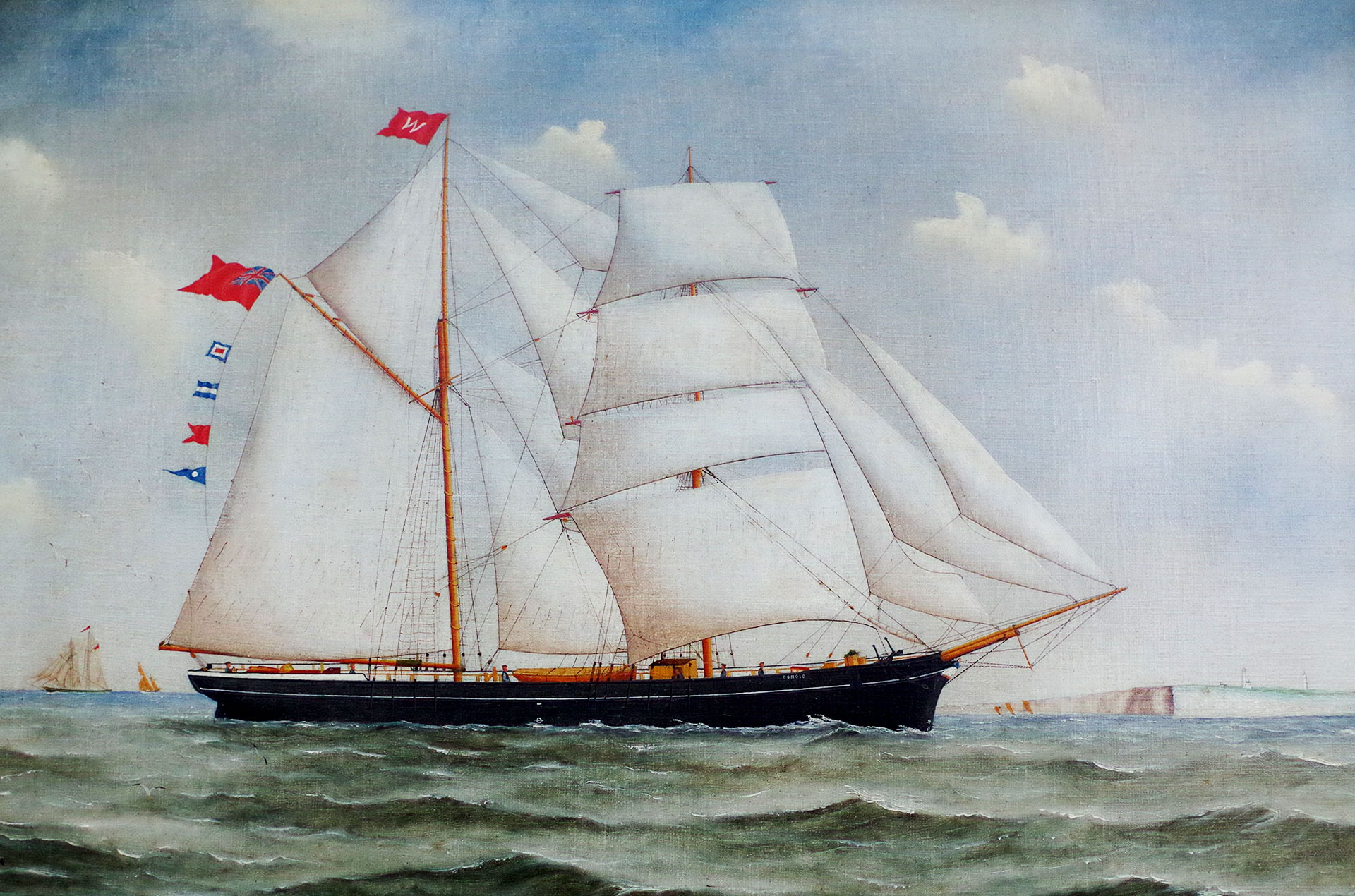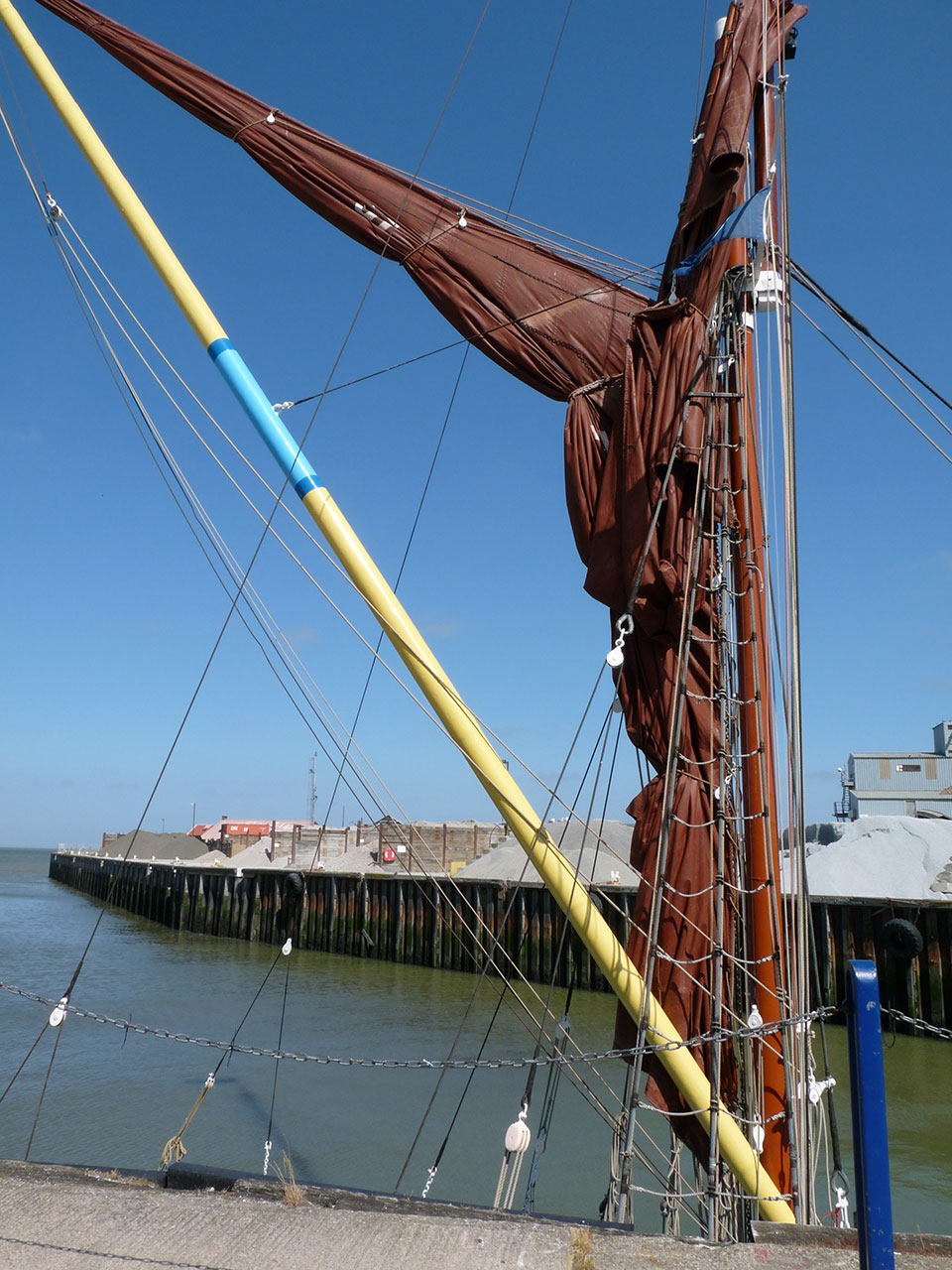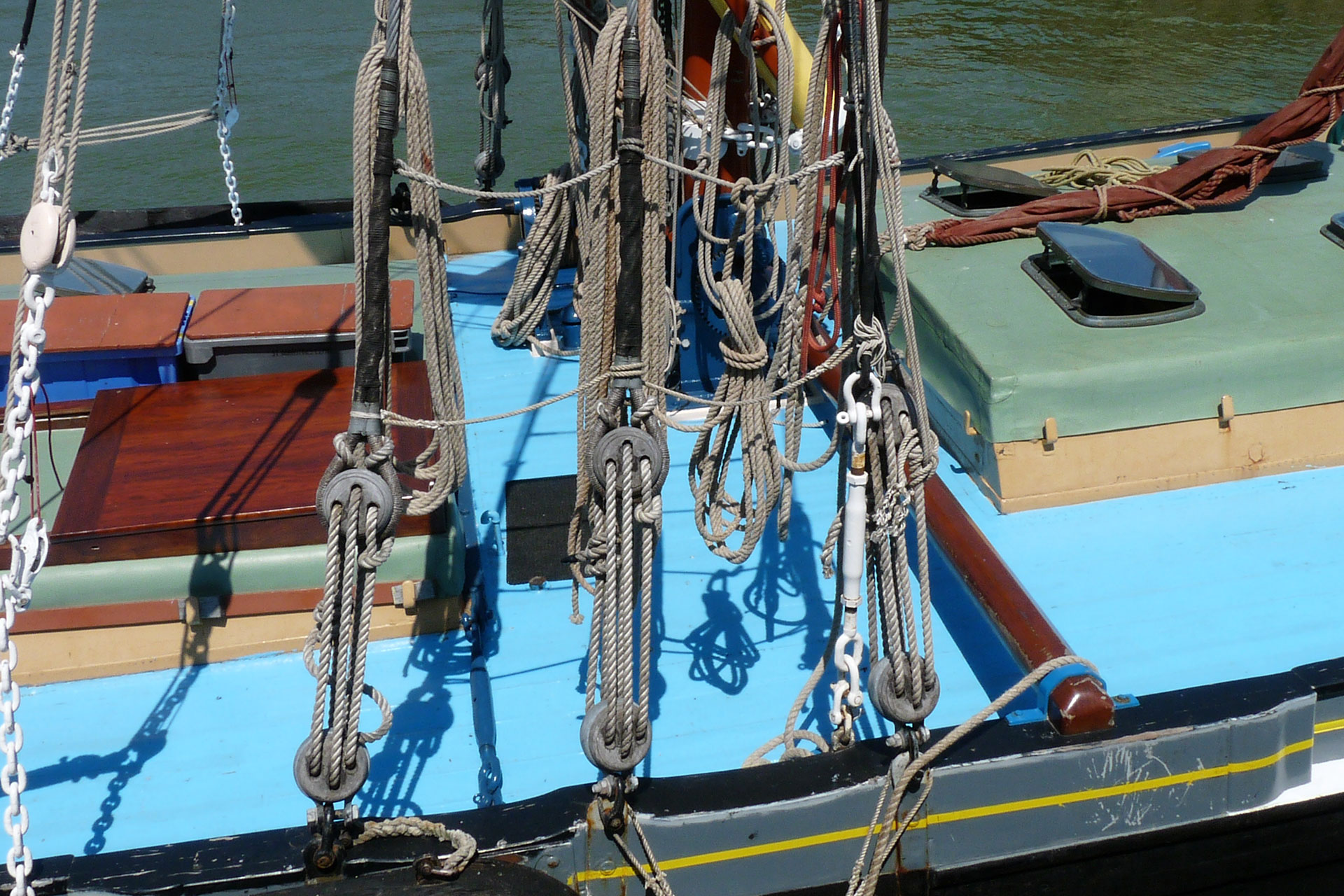Brigantine Conoid – Whitstable Shipping Company – © Jonathan Aylen
Coals to Whitstable – How old technology fades away
Where does old technology go to die? Much effort is spent considering the diffusion of new technologies. But old technologies fade away unremarked.
The fax machine remains central to business life in Japan, but has disappeared elsewhere. Crack steam locomotives were relegated to goods traffic as diesel took over. Elderly jet aircraft are downgraded to freight carrying before being cannibalised for spare parts at boneyards in the Arizona desert and elsewhere. Video hire was once a profitable business. It is no longer fashionable to flaunt an i-pod.
Here we look at the last of the sailing ships. Not the mechanised, modern steel hulled windjammers of the Last Grain Race, but prosaic coasting vessels made of wood – the topsail schooners, the elderly brigantines and boomie barges that carried cargoes such as coal and china clay between small ports around the shores of the UK. These small vessels dominated coastwise trade in the 19th century, but only 2 were left working under sail by 1947.
The Long Decline of Merchant Sail
The long decline of the merchant sailing ship in the twentieth century is a complicated story. UK sailing ship construction last peaked in 1892, and dwindled thereafter. But freight rates jumped dramatically during the First World War from 1915 onwards. This spurred new construction elsewhere in countries blessed with abundant timber and a wooden ship building tradition such as the American West Coast or the East Canadian seaboard. Yet, as Oliver Carpenter shows, the triple-expansion steam engine reigned supreme in British cargo ship construction from the late nineteenth century onward, while the small wooden sailing ship became increasingly marginalised in British coastal waters.
Yet even in the twentieth century, there were minor ports with shallow approaches requiring small cargoes that even small steam tramp ships could not, or would not reach. Capital intensive steam ships could not afford to wait for the tide or dally while primitive cargo handling techniques delayed their departure.
Chalk Ballast North – Coal South
The decline of coastal sail is epitomised by the Whitstable coal trade. Whistable, on the Thames Estuary in East Kent, has a small harbour built in 1832 and was served by the Canterbury-Whitstable Railway (the “Crab and Winkle” line) opened two years earlier. Sailing vessels could tranship modest cargoes of coal directly from their holds to railway wagons using “jumps” to manually lift baskets of coal.
There was a regular coal trade from the staithes of Tyne and Wear in the North-East of England, south to Whitstable where the coal was distributed by rail throughout Kent for domestic fuel and small gasworks in the area. Whitstable was too small to matter, but big enough to provide a profit for local shipping companies. It was the kind of port typified by the yarns of W.W. Jacobs, the now unfashionable author who told shaggy dog stories of little consequence about small cargoes, crewmen and captains on barges and quaysides.
Whitstable Shipping Company
By 1895 there were more than 50 sailing vessels operating out of Whitstable. The major ship owner was the Whitstable Shipping Company formed in October 1885 by two independent Whitstable shipowners, J.R. Daniels and G.H. Gann. They had their own shipyard to repair and maintain their sailing fleet and even branched out into building ketch barges in 1890. They diversified into spritsail barges from 1893 onward for local trades up and down the Thames Estuary to London.
Unlike other ship owners, the Whitstable Shipping Company did not make the transition to steam colliers. Instead they bought and maintained a large fleet of predominantly second-hand sailing vessels which regularly plied their trade to Sunderland and Tyneside carrying ballast north and coal back south.
Brigantine Conoid
Typical of these vessels was the brigantine Conoid, shown here sailing northwards past Flamborough Head, painted by a Sunderland river policeman John Fannen in 1899 for W. Joiner, who had been her master in 1897-98. Conoid was launched in Peterhead for local owners in January 1865, but moved to Whitstable in 1884. She was taken over by the Whitstable Shipping Company after various local owners in October 1885. Just under 100 feet long, less than 25 feet wide and requiring only 11 feet 5 inches of water, she carried coal from the North-East to Whitstable and other small Kent ports such as Folkestone.
Accounts survive for the Conoid: Take a typical round trip voyage – Whitstable to Whitstable – as war broke out in July / August 1914. Outward bound, Conoid shipped 250 tons of spent ore from a gas works in Barking on the Thames in London for the Tyne, perhaps for Tennant’s Alkali Works on the south bank at Hebburn on the south bank of the River Tyne. It must have been a vile cargo as the crew were paid an extra one guinea “gratuity on burnt ore”. Conoid then collected coal at Seaham, County Durham for the voyage back to Kent. The costs of the round trip was close to £89, the revenue little more than £102 giving a profit of £13 for seven and a half weeks work by a crew of six! Total profit for the whole year, September 1913 to September 1914, was just under £155 on seven round trip voyages. We should not be romantic though, as this was tough, even brutal and certainly dangerous work up and down the East Coast of England in all weathers.
Conoid was later sold to Fowey, Cornwall in 1917. By then she was 52 years old and seems to have been re-rigged as a three masted schooner in Cornwall, presumably to reduce manning levels. This new rig did not last long though, as Conoid was sunk on 29th March 1917 by gunfire from the German submarine UB-40, three-and-a-half nautical miles north of Cape Barfleur, on a passage from Fowey to Rouen carrying china clay – the crew survived. These war losses hastened the disappearance of the coastal sailing vessel.
Dwindling Fleets
Many Whitstable Shipping Company vessels were commandeered by the Government at the outbreak of the First World War and by 1917 the Company had sold out to Daniels Bros who remained in the sailing barge trade. The days of the coastal sailing vessel were over as fleets dwindled in the inter-war years. The last of the old vessels either wore out, or were converted to motor ships with diesel propulsion.
However, in the Shock of the Old, historian David Edgerton points out that many discarded technologies still thrive in emerging economies. For example, sailing vessels little different to their nineteenth century predecessors continued to trade in the Indian Ocean with cargoes of rice, from what was then Burma, to Ceylon and India up until the 1950’s.
Are you a member of the Newcomen Society?
Having just celebrated its Centenary Year, the society has published over a 1000 papers in The Journal – an invaluable archive of original research material published twice a year, covering all aspects of engineering from ancient times to the present, plus available to browse and download in our FREE TO MEMBERS Archive.
Full Membership includes:
- Journal for the History of Engineering & Technology (two issues, one volume per year)
- Printed and/or PDF versions of LINKS, Newcomens’ newsletter (published 4 times a year)
- Free access and download facilities to the Society’s Archive of past papers back to 1920 (The Journal)
- Membership of local branches and subject groups
- Access to the website’s Member Area offering access to research sources & access to other members (subject to privacy permissions)
- Attendance at summer meetings, conferences, lectures and study days.







Dear Jonathan
I seem to remember, from what I dug up for the 2018 meeting that the Tees was also involved in the coal out, chalk in business to some extent. The extensive deposits of boulder clay on Teesside would have been useful in cement manufacture. Was that your impression?
Also in the Onedin Line series, in one of the later episodes, James Onedin asserted he was not too worried about the threat from coal. There would be plenty of business transporting coal itself around the growing coaling ports of world trade.
As an observation, any infrastructure that could / would service & maintain wooden sailing coasters must have been on diminishing returns by WW1 & becoming expensive. Possibly not helped by a skills shortage post 1918.
Manpower costs alone, when set alongside those of motor vessels, would go against them. The manoeuvrability of a steel-hulled motored coaster having a greater advantage, with the added benefit of needing less crew.
Another factor favouring motored vessels would be minimal encumbrances to load handling i.e. masts, spars, & rigging. It’s easy to see that they would fall out of favour. Motor vessels probably allowed for a speedier “turn round” which ports & harbours probably preferred.
Fred,
The Tees was certainly involved in coal shipping. The Stockton and Darlington railway may have been meant to carry coal for local sale, but they soon put up the first of four staiths at Stockton in 1827, as the model of the railway in the Head of Steam Museum at Darlington North Station shows.
The meandering river Tees restricted the flow of ships. Terry Powell’s excellent short book “Staith to Conveyer: An Illustrated History of Coal Shipping Machinery” (Chilton Ironworks, 2000) shows how the coal staiths migrated down the Tees towards the sea during the 19th century.
The Stockton and Darlington Railway soon developed Port Darlington, three-and-a-half miles downstream. As you explained during the Newcomen Society Tour of Teesside in 2018 Fred, the Clarence Railway also opened a rival set of staiths from 1834 at Port Clarence, with direct rail access to the Durham coalfield. Silting of the tidal river Tees made a wet dock inevitable, and Middlesbrough Docks opened in 1842. The Teesside shipping facilities were soon eclipsed by the Docks at West Hartlepool opened in 1847 which offered lower dues and rapid turn-rounds.
Ballast was a contentious issue. Roger Finch reports in “Coals from Newcastle” (Terence Dalton, 1973) that ballast was often just gravel gathered laboriously by dredging the immediate river bed. You are right that chalk gathered from around the Thames might have an economic value on arrival in the North-East, for instance to the lime burners of South Shields. More often than not ballast was dumped at ballast quays where it accumulated in riverside mounds.
Sailing ships certainly carried bunker coal for steamships around the world up to the early years of the 20th century. This was just part of the symbiotic relationship between steam and sailing vessels. Steam tugs were vital in allowing sailing ships to enter and leave port, regardless of wind conditions and allowed larger deep sea square rigged ships to remain viable. Steam dredgers were developed from the early 19th century onwards to make rivers more accessible. Later sailing vessel designs in iron and steel borrowed heavily from steam shipbuilding practice.
Bob,
Very much agree. It is certainly true that crews were hard to find by 1918 at the end of the First World War. Coastal vessels sailed short-handed, making cargo working particularly tough for smaller crews. Some sailing vessels fitted motor winches as a labour-saving device to help with tasks such as cargo handling and raising anchor.
The crew of a steam collier was much the same as that of a topsail schooner or brigantine, but their carrying capacity was much greater. This meant much higher productivity from both vessel and crew. Records show a brigantine such as Conoid would carry a crew of 5 or 6 and ship maybe 200 – 270 tons of cargo at a time. A small steamer in the coal trade had maybe 7 to 9 crew: master, mate, chief and second engineer, two able seamen, an ordinary seaman and a couple of firemen. But they would carry from 600 to 1,000 tons far more reliably and swiftly.
Life was much easier as a seaman on a steam ship. Keeping watch in a warm, dry wheelhouse on a tramp ship was much to be preferred to sail handling on a wet, windy day.
Steamships had priority at the staiths, while sailing vessels had to wait their turn until gaps became available. Notice the Conoid collected coal at Seaham for its return voyage at the beginning of the war. The obsolete coal drops at this small port were better suited to sailing vessels than the more modern handling facilities on the Tyne or at Hartlepool designed for the larger holds of steam colliers.
As you say, the rigging got in the way when loading and unloading sailing vessels. The boom and gaff had to be swung away to allow coal to be shot into the hold from above. Small hatches meant much effort in trimming the cargo after loading. Whereas steam tramps were designed with large hatches and holds free from obstruction to allow for rapid cargo handling.
Shares in sailing vessels were often held in sixty-fourths. In this fashion other members of a coastal community could invest in the fortunes of a vessel and expect a steady return on capital. Investors often included ships chandlers, local boat builders and sailmakers. This meant the prosperity of a port was tied to the fortunes of its ships. As the number of coastal sailing vessels dwindled, so did the prosperity of ports that served them.
I briefly worked for Daniels Bros Crescent Line Shipping Line based at Whitstable Harbour. They managed import/export of goods to Esbjerg on the MV Resurgence. Bills of Lading were sent via teletext as soon as the vessel left the port. I think the building was demolished in the late 1970s.